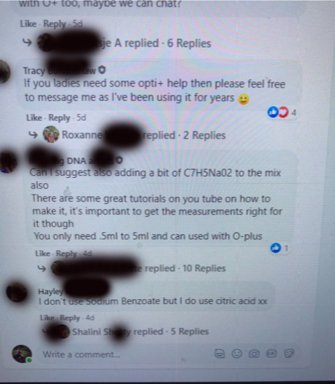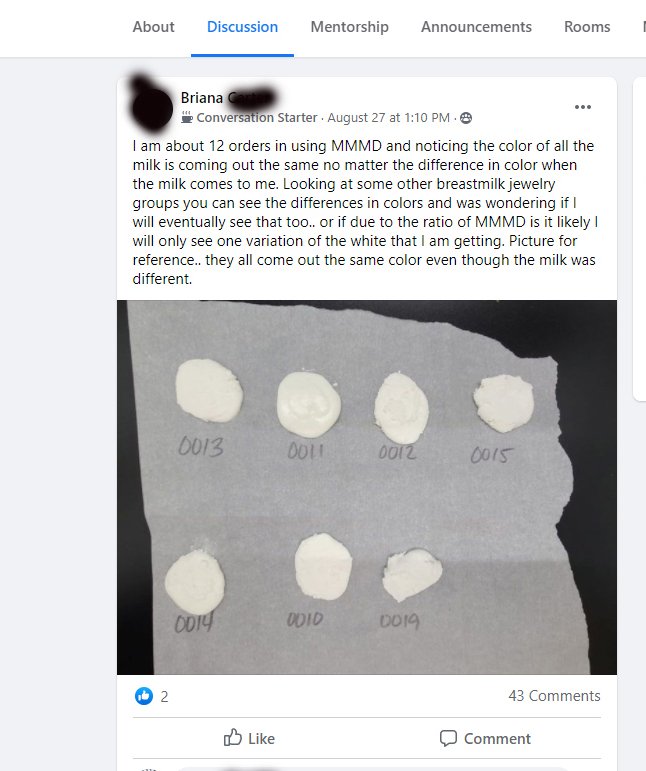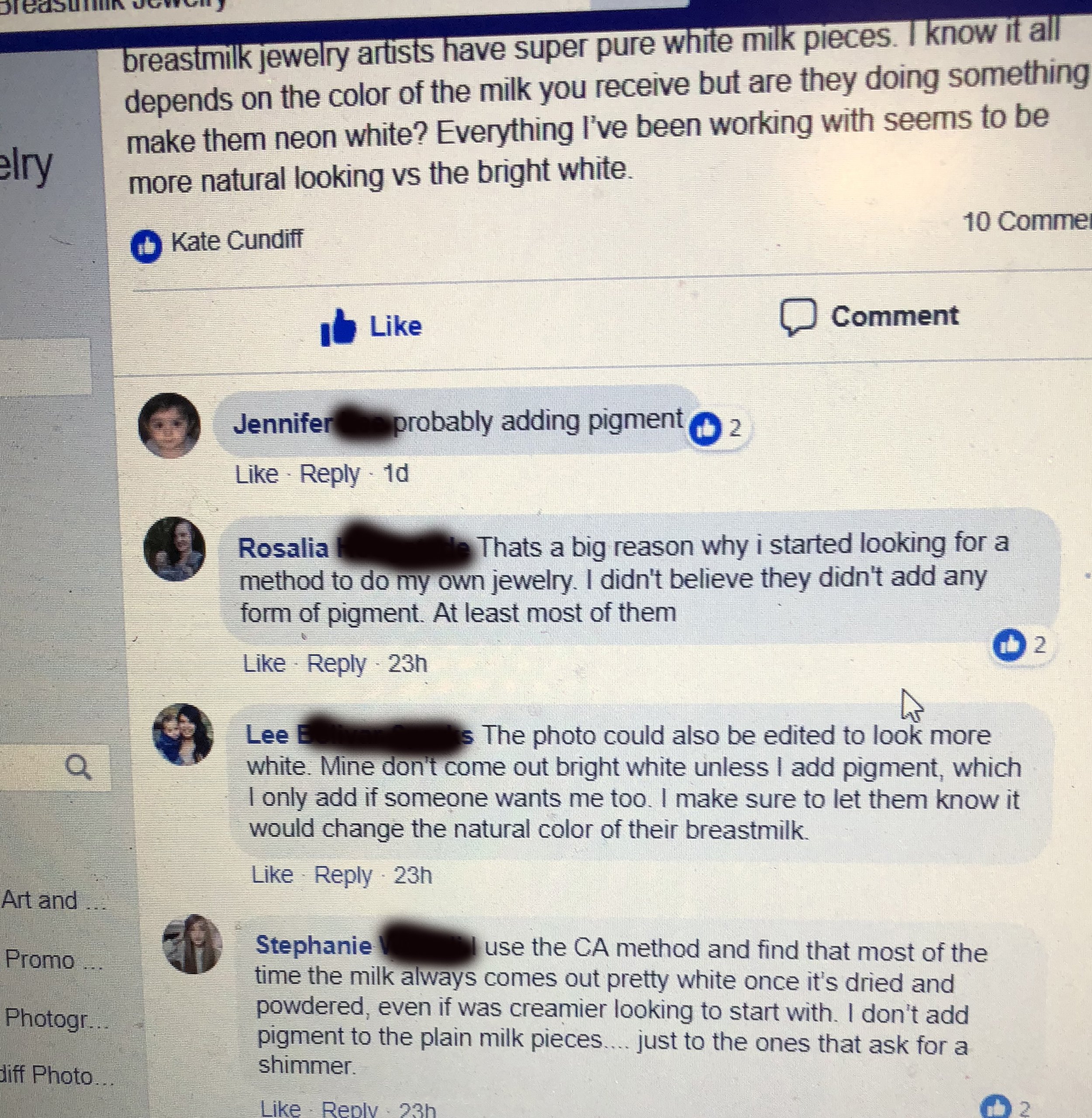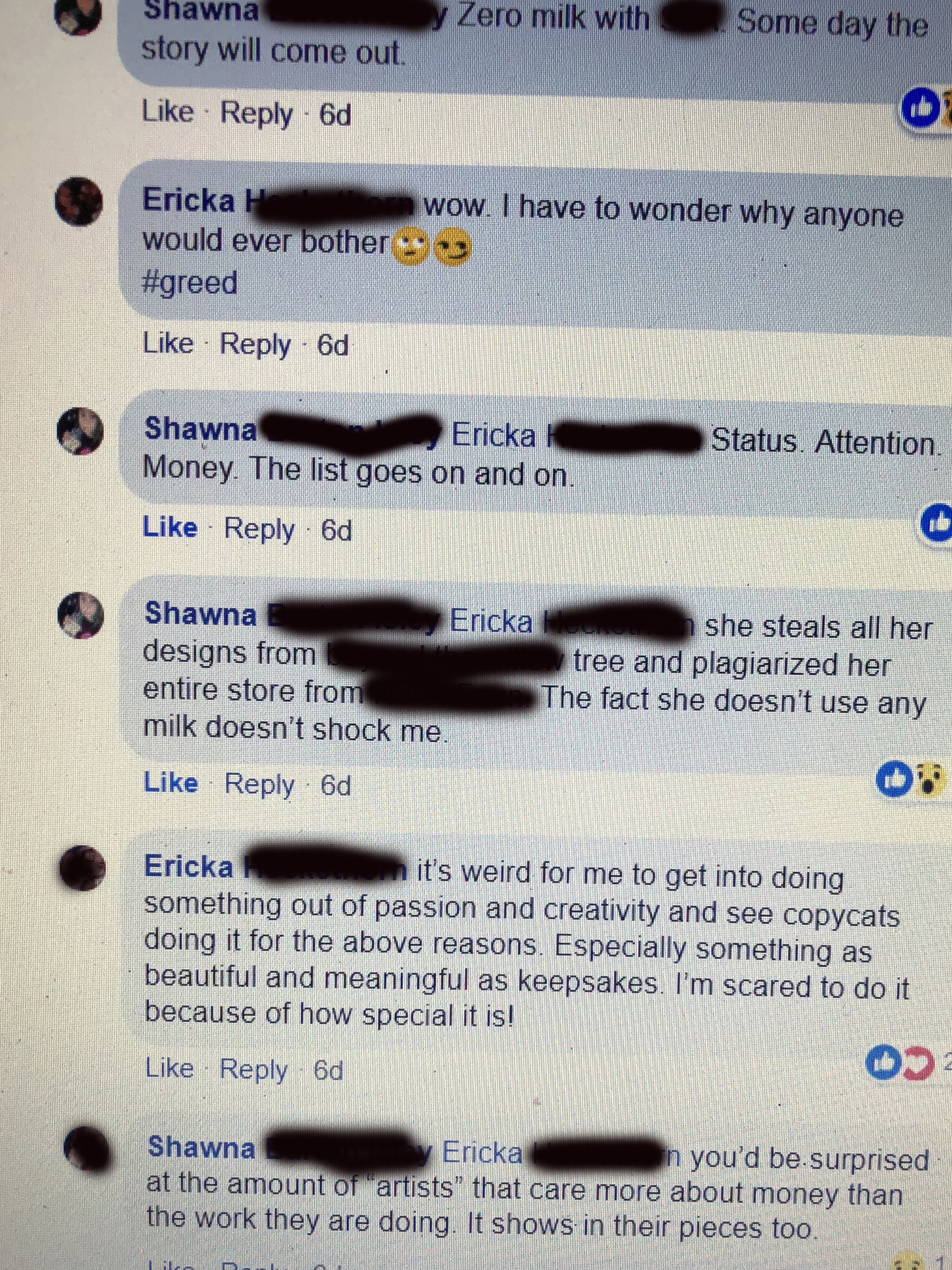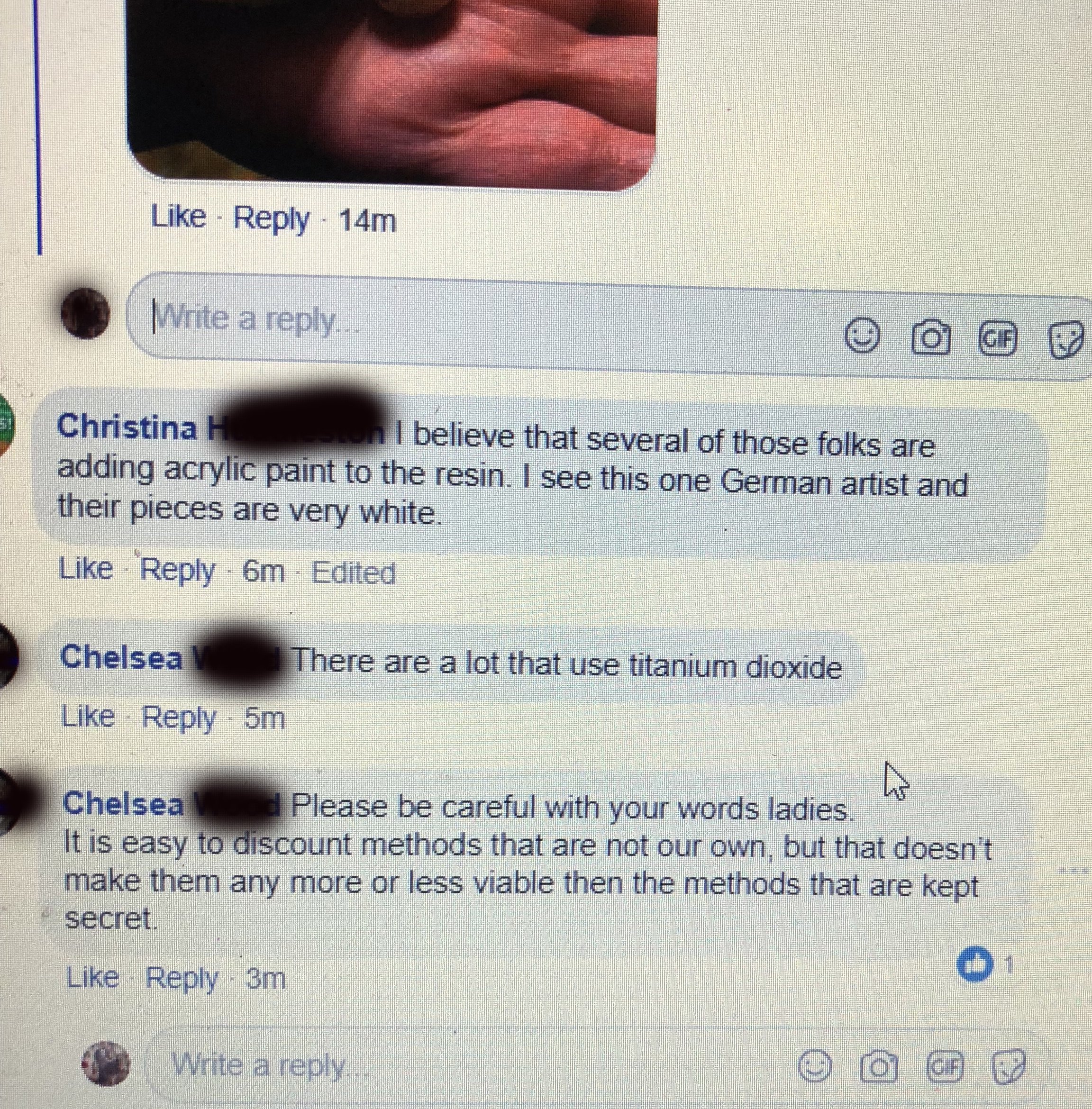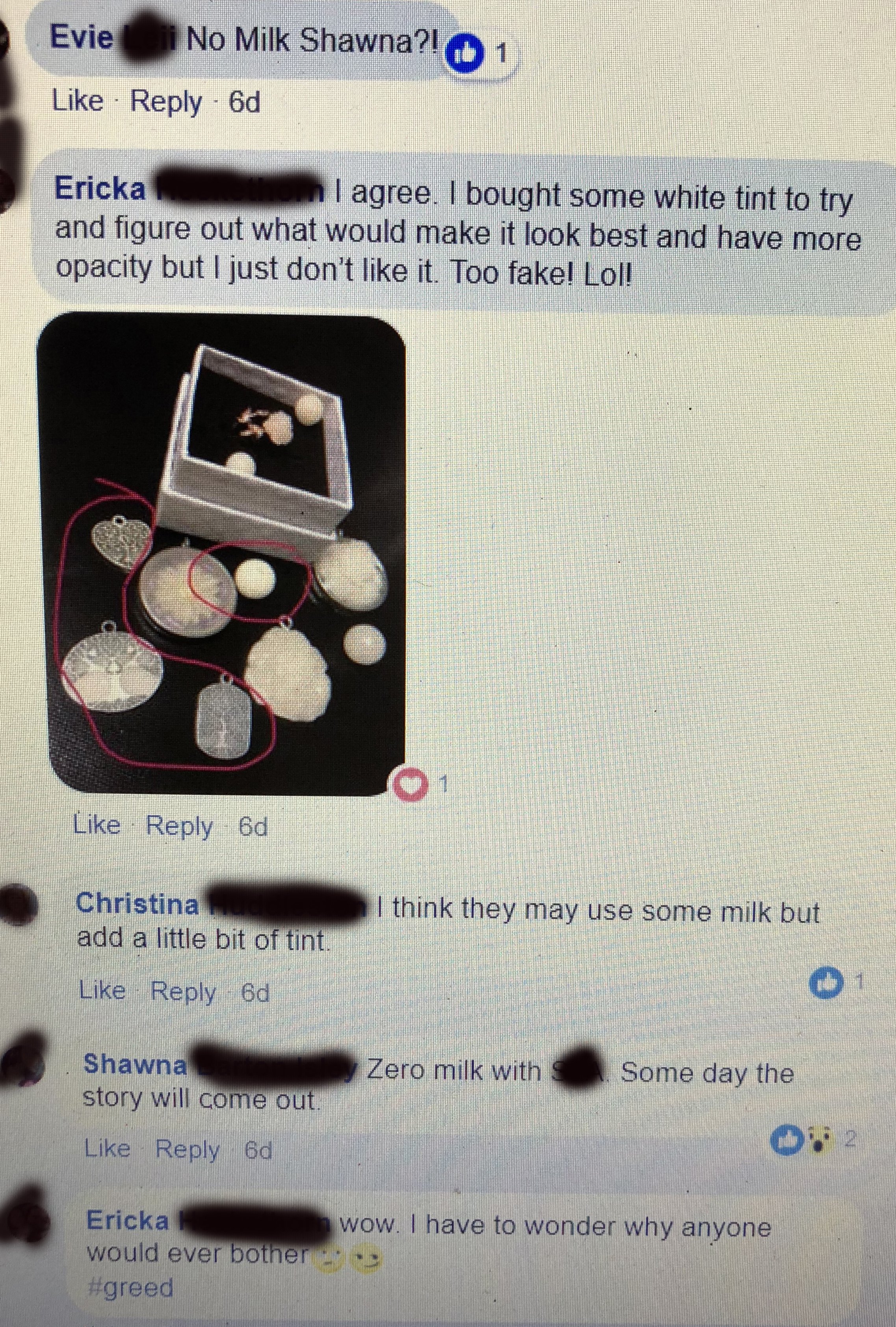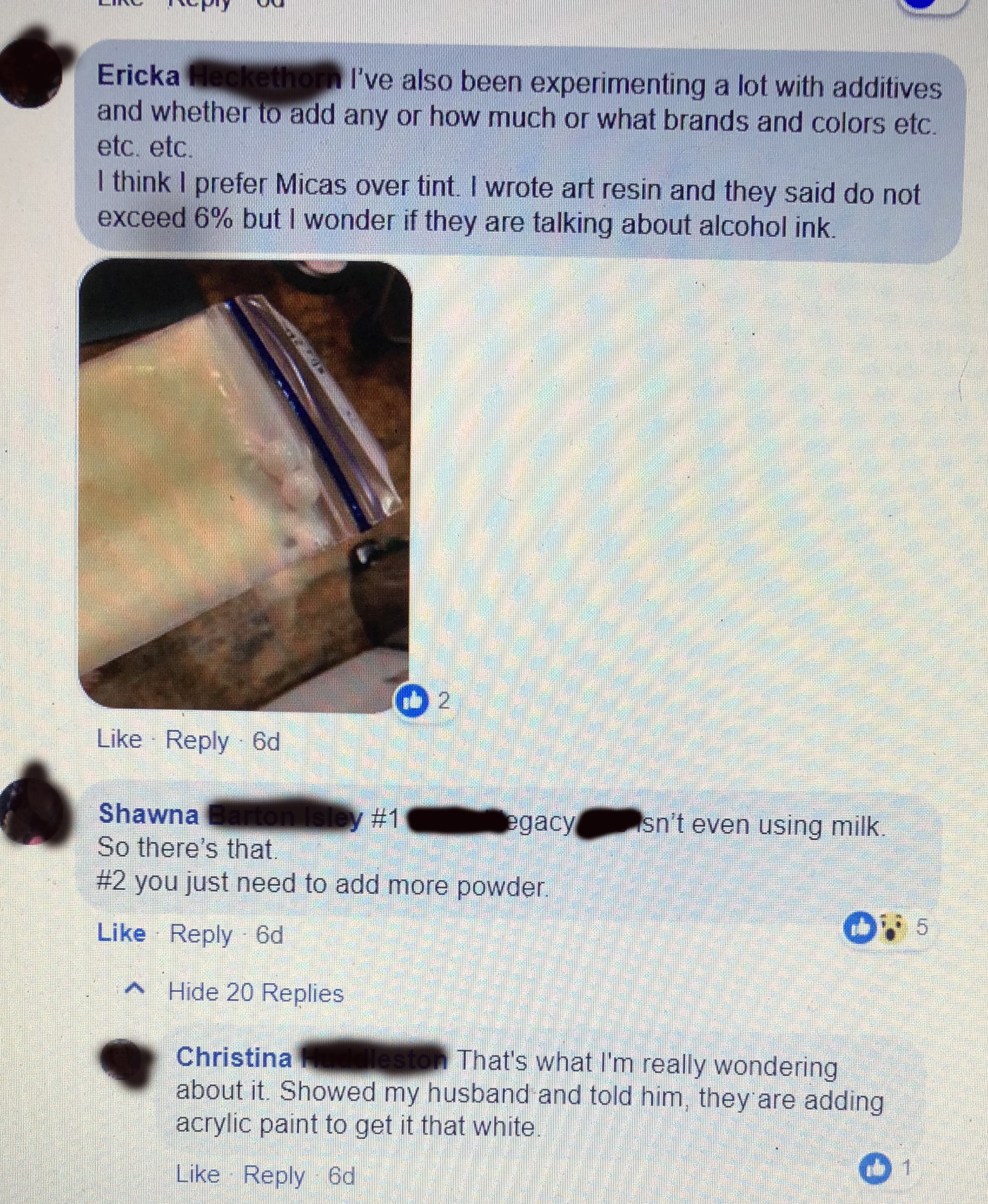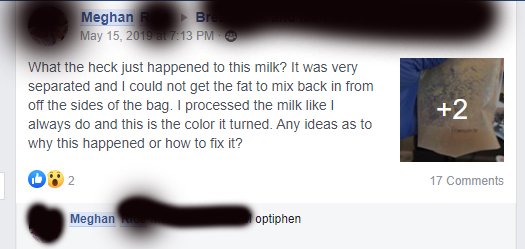I’ve been in the industry for several years and have seen so many people come and go as well as so much go on behind the scenes. Having been removed from groups after trying to understand why some think it’s ok to be deceitful to clients, I did happen to grab some screen captures before officially being booted. Other big-time crafters should be ashamed of some of the things they do or advise their pupils to do. Everything from harsh chemicals to tints. Not only that, but you see how some people do their practice and intermingle client’s milks. It’s all been pretty eye-opening.
While some of these mentioned additives aren’t the most unsafe I’ve seen mentioned in past years, they still DO impact color, and adding more isn’t the answer to keep the milk pure. You want less, you want the closest thing to just milk as you can get.
You’d be sad to learn some of these crafters commenting are BIG TIME creators who are being trusted to preserve real clients’ milk. I think MOST creators mean well, they just haven’t opened their eyes that their method isn’t very pure and became blind once they start getting paid. At the end of the day, it’s up to the consumer to be aware of the kind of businesses they are using. Either way, I suggest vetting your creator as well as seeing how long they’ve been in business AND that they are an actual business. In the event you have an issue with your piece, you don’t want to use a source that has no legal backing to their brand.
Comparing Breastmilk Preservation Recipes
Here is a good example of three breastmilk preservation method recipes. Images are taken in natural light with a DSLR on Manual mode.
In the cup, I have the same batch of breastmilk used for the experiment so you can compare the examples of methods WITH the actual milk. The top image is after it has dried (you can see it preserved on my other blogs or YouTube), and the bottom is after is has been crushed.
Here we have my method on the left. It doesn't make nearly the amount the other two do, but remember, it also doesn't have nearly the filler "substances." Also, take note, that my method is not meant to be dried out, I did so for the sake of keeping the experiment fair. (You can also see my method in the wet form as it is used via a previous post.)
The second, towards the bottom, is the CA method. You can read more about this method in previous posts.
Lastly, the famous MM breastmilk preservation powder recipe on the right. You can read more about this method in a previous post as well. - As you see, it retains the least amount of actual breastmilk color out of the methods shown. I still don't understand why this became the "go-to" recipe for breastmilk preservation. It CLEARLY has pigment in it. It made it big because the lady who started creating it didn’t tell the whole truth or the full result of the method, and didn’t care while the people in her group blindly followed.
This is why you should ask what method your DNA artist is using, and ask them to show you the method of preservation with water. This way, you can make an informed choice about your keepsake, asking this gives you a great idea as to how much your milk will actually be coloring your piece. While they don’t owe you their recipe, if they don’t want to tell you ANYTHING, that is a big red flag.
Famous powder/dust, the CA method, my method (dried), and the actual milk used for this experiment.
DIY Breastmilk Preservation Recipe
There are a few ways you can do this depending on how ethical and stable you want your preservation to be. Naturally, you are going to want the best of the best, let’s be real. Unfortunately, you aren’t going to find too many people giving that information out for stable, well-established formulas.
Some are more ethical than others, but if you are making it yourself you are well in the know of what you are putting into your piece.
This DIY method is easy and you can get most of the items quickly. Please note this method is NOT professional grade.
You can see the below method done on a previous blog post or my YouTube.
Resin
You will want 5 ml of Citric Acid
5ml of breastmilk
(titanium dioxide) if you choose
Mix together and evaporate off the liquid in a double boiler method until the mixture becomes a paste.
Flatten onto parchment paper to dry for 1 week. Silica gel sand helps this process as well.
Once dried mix with your resin and cast. - I recommend sealing your piece to give it extra protection.
The famous powder dust is made with various ingredients. Most are not public, but I speculate a lot of them are filled with titanium dioxide, plaster, citric acid, and other finely ground powders. Most of all, whatever they are using is highly pigmented. I’d assume things used in the powders are anything from safe products to dangerous chemicals. BE CAREFUL ordering, using, and creating these products.
Not all preservation methods are created equal Pt 1.
Let's real talk for a minute.
When you buy, let's say, honey from a beekeeper, are you expecting all raw honey in the bottle you purchased? Or are you okay with it being "honey syrup" made mostly with high fructose corn syrup/dyes and only a fraction of real honey? - THAT is the difference between some breastmilk jewelry methods.
While your artist doesn't owe you their method in detail, they can, and should give you an idea of what does or doesn't go into their processes. Can they add their solvents to water and still have a clear or at least transparent "pure" result? You can ask them to do this and if they won’t that should be a RED FLAG. Do they use more of their solvents than your milk? Do they evaporate off most of the milk you sent? - Have you ever boiled breastmilk? It evaporates quickly and almost entirely. Try it. Some artists seemed to have found a loophole to use tints. The package doesn’t state it has pigments, no powder maker is going to admit that to you, so the crafter who purchased it can “white lie” by telling you no tints because they have NO idea. Common sense tells us that just because something doesn’t say it is a tint, it can still impact the color of something, meaning it ACTS like a tint. Don’t let your artist fool you with loopholes and white lies. A strawberry doesn’t call itself a tint either, but it can be used as a dye, just as those powders are doing to what VERY little is left of your milk.
Then we get into chemicals used. If your crafter doesn’t have their own method they have NO idea what they are using in your piece.
My method is a proprietary "wet method" which means your milk is not evaporated off or dried out before it is put into resin. The milk is still in a "wet" form when it is preserved, stabilized, and then cast into your milk gem. NOTHING that contains pigments or tints are added to your milk. My method is your milk with two clear solvents working with the fats in YOUR milk and that's it. (Please note again, "wet" does not mean it hasn't been preserved and prepared to go into the resin.)
My biggest goal when setting out to create my own method was to make sure to keep the method authentic and genuine to MY milk, not a filler. Once your pieces cure-out they are a more natural milk color. Goal achieved for what I wanted in my method. My method is absolutely not for everyone, but I find honesty and integrity in my work very important. As a mother who breastfed all 4 of her children, I only make what I would personally want. I didn't want to cherish a piece made with filler powder and perhaps only traces of my milk. I'd have been devastated to spend hundreds of dollars on a piece only to find out it was packed with a filler or evaporated off.
I worked a really long time, completely on my own, like a mad Scientist for a method. This is where my heart is at. I wasn’t given a method to run with, like most other artists out there. I built my business and waited before selling to be sure my method held up. It’s frustrating to see so many artists already opened up and STILL looking for a new method.- You get your method working THEN start your business and so many have done it the opposite way. DO your research on your artist and their method.
Ask your artist to mix the powder or solvents with water and you can see the impact of their preservation will have on your milk. Ask your artist questions. . you’re allowed.
Top reasons I stand behind my method.
1. Pieces do not rot
2. It contains more of your milk than anything else added(other than resin, of course)
3. I don't evaporate off your milk in the process, at all.
4. There is no powder base or solvents that act as tints or filler.
5. More of a natural color upon cure-out, which happens with the fats in YOUR milk. That means, it is unique to you.
6. No hazardous chemicals used to preserve. Everything in my process is food grade- Like, I could literally feed it to my child and not need to run to the ER. - Some crafters don't even know what the powder they are using contains, which is also a really scary fact. Others use chemicals known to cause cancer, respiratory problems, hormonal imbalances, etc. I KNOW what I am working with because I made it. The most dangerous chemical in my process is the resin itself and I can’t do much to change that. I do work with a food grade resin and not a poly resin
7. I can also make pieces that stay bright white too, the difference is you have to ask me to have a tint added. It isn't added as the base preservation, like the powder method, which for all the ones who outsource the powder know, all it is, is tint. We don't know and they can’t tell you either because they have no idea.
8. Having sourced all of my own preservation materials I can keep my prices affordable.
That being said, if you see a crafter making theirs with powder and you love that piece, buy it. You are still going to love it. It doesn't make it any less of a piece, but you as a consumer should be allowed to be enough aware to make the choice. And your crafter shouldn't conceal that. My main point here is lack of honesty and the amount of milk that actually goes into that method. So many artists want to sweep it under the rug for their own gain.
I will be doing an in-depth video and blog post about this soon. AND I recently got my hands on some of the preservation dust, so I am going to show you HOW much it changes water. I knew it would, but I was even shocked at HOW much. Not sure how anyone can use this method and not question the integrity behind it. I’m also seeing a few of the artists complain of skin reactions. This could be from a number of things, like resin, curing lamps, or mmmmmm maybe the powder they are using?? Food for thought?
While there are several ways to make breastmilk jewelry, they are NOT all created equal. Someone, somewhere has to raise a little awareness instead of following the herd. Being a leader means taking a stand when no one else will, even when it means not everyone likes what you have to say. Hopefully, this will widen some eyes instead of starting a war. If you don’t like me merely for the things I have to say about this process, maybe you should rethink WHY you don’t like me or what I have to say.
Preserved breastmilk ready to go into the resin for a piece of jewelry. (Small amount as I was only making a small gem.)
Cured out breastmilk pearl (roughly 5 years old) with the breastmilk it was cast from. They are soooooo alike it makes me giddy.
Proving there is Breastmilk in your jewelry
Ok, for the first real content blog on the page, today I am going to cover the newest “fad” in breastmilk jewelry. Testing to see if milk is really in your piece.
I am in a few groups for DNA artists and it's usually a battle to get anyone to understand where you are coming from when trying to chat about certain methods unless you agree with them. -Anyway, people are against my outlook on the powder method and it stirred the theoretical pot. In that whirlwind, I was also removed from a group and another artists started to claim she could tell what pieces have milk or tints. - I just felt compelled to test her claim. I’d happily send her a piece in exchange for one of hers.- I’m that confident in my own method.
I decided to set out the very next day with my own trial on her experiment because I can’t call it junk or deem it worthy if I have no first-hand knowledge with it. I like Science and am always up for a good challenge and experiment to take part in. This is how we learn and how we improve.
**** Before I go on further I am going to say this, PLEASE DO NOT EVER DO THIS IN YOUR HOME- IN YOUR OVEN-AROUND YOUR KIDS AND PETS-EVER! EVER! I am using a craft oven in my open garage and also am using PPE as this is a NASTY, NASTY, dangerous thing to be doing. (And quite irresponsible of the artist to tell people to do in their homes, not giving any sort of disclaimer and saying it is up to the client to know.) Sorry, but most people who don’t work with resin likely wouldn’t know any better. - That’s why disclaimers are put on all types of things; to be informative. Any DNA artist knows most people have 0 knowledge how dangerous it could be via that guidance.) Don’t do it!****
If you find the tik toc video, they look to be using a standard oven and does not seem to tell viewers how dangerous it is. That video should have been started 100% with a disclaimer, not only for the fumes, but also the pans and oven you are told to use. BIG NO! You HAVE to care about your clients and just others in general. This could literally KILL people with severe asthma or certain sensitive pets, like birds and reptiles. I am here to tell you DO NOT DO THIS EXPERIMENT! If you must see, please ask your artist to do it for you via a video or images. - If you cannot trust your artist beyond that you probably shouldn't be ordering from them. Truthfully, if you tell me you need an extra gem, at no charge- to bake, it's unlikely I am going to give you one. I only give extra pieces when I have extra pour, it's not always typical. What you do with any extra is your business, but I don't advise wasting it on something like this when I have already done it.
So, why am I posting this? Because a lot of the artists/groups want to censor what is out there. IT IS ALREADY OUT THERE SO TALK ABOUT IT! SCREAM ABOUT HOW TO DO IT SAFELY! OR WHY NOT TO AT ALL! DON’T CENSOR IT AND PUT IT UNDER THE RUG! Censoring doesn’t make it vanish, it only keeps information that would have been useful and safe at bay. Good thing for me I have my own platform and an IQ enough to know that it is already public. I will take it upon myself to make sure it is posted how to do so properly. - The method is out there, so it may as well be talked about for what it is AND for how to properly do it, right? It's only going to gain popularity. - This was not the first artist to have a similar claim, just the first one to take it public. Better to have GOOD, ACCURATE info about it than sweeping it under the rug like some would prefer to do. I was happy a handful of other artists did reach out via messenger in support of both the baking method being brought to light AND my points with the powder methods. You don’t have to fully agree with someone to have a discussion. Open minds create the future.
Again, do NOT do this without ALL precautions as it could cause severe allergic reactions for weeks or months at a time.
******************************************************************************************************************************************************************
Ok, here's the deal. Another artist released a method to prove or discredit other artists milk purity (or use) of milk in their jewelry. I felt compelled to try it as she had just removed me from her group for speaking up about the powder method. My factual information was censored and I was removed. I don’t feel quite as offended knowing that seems to be a common trend over disagreements. A lot of the artists don't think my wet method is even possible, though I assure you, with the right Science, it is. :)
With this “proof” method, you supposedly can bake your breastmilk pieces in a oven, at high temps for a few minutes and then you have your result. If your pieces brown, there is milk. If they stay white they were packed with filler and or tints.
For my first attempt at trialing this method it DID work for my preservation method. My raw breastmilk pieces turned brown and the decoy tinted piece stayed fairly white. With that said, the piece with 0% milk did change a tiny bit, but was more of a marbled look, not a uniform brown, like the others. Also, the pieces made with shimmer and or flecks didn't get AS brown as the raw milk pieces. If nothing else, this further proves my points about the powder method NOT being so tried and true (“pure”) after all. - IT IS MOSTLY FILLER and DOES have tints. I would ADORE to see some trials of this done with the famous dusts/powders. - I have a hunch that's why my post was removed. No one wants this gaining traction, not just for health risk, but for being afraid of their own methods stacking up. Maybe that’s my opinion, but it seems fishy to me.
Bottom line, I am willing to do what I can to prove my method contains milk because it does and I feel it is one of the most pure methods out there right now. I do what I can, when I can, but I don't recommend trying this on your own. If you want to see it, have your artist show you. They SHOULD be willing to as they can do it once and document their results. One and done and counter top ovens are a dime a dozen at a thrift shop or marketplace.
There are still flaws with this method proving or discrediting other artists. Too many variables go into why it does or doesn't work with methods. I'd love to see some other artists (properly protected) doing their preservation method with baking. We definitely need more artists to take part before it could be deemed 100% a way to tell. Because how do we know it would work with every method or add-in? What about age of the piece? If the piece is sealed?(which all of my set gems are, the ones I baked were not as they weren't set.) SO many things could go into why a piece does or doesn’t change. I’d like to see a controlled experiment with a bunch of artists trading pieces to trial to keep it fair and non-bias.
All in all, the take away from this is. …. . It is VERY dangerous and still too new of a method to prove or discredit if it is a “tried and true” way to tell.
Please do not message me asking for the link to the video or to the powders/dusts. A simple google search has the worlds end at your finger tips.
I will do a few more tests, just to get a better understanding, and will definitely try to do so during the day/with my pro camera so the images will be better as well.
Stay safe!
The following images are from my first attempt at the method. I used my phone to photograph in my dark kitchen.
Top pearl is the decoy tinted piece. Cluster of gems: Two raw milk gems, core bead with colostrum, gems under are with shimmer and other with shimmer and opal flecks. Small gem in the right corner: opal flecks.

